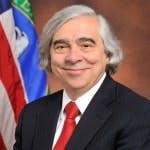Ernest Moniz, US energy secretary
It says something that Ernest Moniz chose to deliver his first public talk as US energy secretary to an energy efficiency crowd.
His appearance May 16, 2013 at EE Global in Washington, D.C. was a surprise of sorts. And the timing was significant. Moniz had only been confirmed as energy secretary three hours before taking the podium at the Alliance to Save Energy’s annual conference.
Why did he make the stop?
Probably not because of the size of the crowd. About 550 people attended the two-day gathering. For the energy efficiency industry, these are impressive figures, but by energy conference standards in general, not so much. Ten thousand people attended the American Wind Energy Association’s most recent annual gathering and Solar Power International drew 15,000.
Nor was it likely because of the crowd’s influence. The big money in energy lies elsewhere, with the utilities and the oil and gas industries, which have contributed the bulk of the $91 million spent lobbying Congress on energy issues so far this year, according to the Center for Responsive Politics. Energy efficiency companies represented only a smattering.
Instead, Moniz’ presence signaled not what the energy efficiency industry is today, but where it’s going – quickly – and the Obama administration’s willingness to help it get there.
In fact, Moniz called the timing of the efficiency conference and his nomination “fortuitous” because of the aligned agendas. “Efficiency is going to be a big focus as we go forward,” he said.
Energy efficiency is poised to be the next big thing in clean energy, ready to take the steps two at a time, as the wind and solar industries have in recent years. (The US wind industry grew 500 percent from 2006-2012; solar has grown almost 300 percent based on megawatts installed)
Energy efficiency’s growth is being fueled by several factors, not the least of which is economic. The market is working in its favor. Energy prices are up and efficiency offers a way to get them down.
The US Energy Information Administration projects that electricity prices will grow 2.6 percent in 2013, almost double the 1.4 percent increase in 2012. This follows a $720 million rise in energy costs from 2002 to 2011, almost as great as the US’ jump in healthcare costs during that time frame, according to a report released at the conference by United Technologies Corp.
“Energy prices have risen to the level where avoiding the cost becomes the investment opportunity. I think that opportunity will only grow,” said John Mandyck, chief sustainability officer for United Technologies Climate, Control & Security, in an interview.
In fact, UTC found in a report that a 30 percent increase in building efficiency would not only pay for itself, but also generate a net positive cash flow of $65 million per year. This beats the rate of return for corporate bonds, according to Mandyck.
That’s the good news.
The bad news is that as energy efficiency grows in stature, it is likely to attract some of the same enemies as the wind and solar industries. For a look at one of these confrontations – a 12-year confrontation – see this story about Cape Wind’s battle with oil billionaire Bill Koch.
The wolf has already shown up at the door in the Northeast, according to Susan Coakley, executive director of the Northeast Energy Efficiency Partnerships. The Northeast, in particular Massachusetts, is one of the most active energy efficiency markets in the US.
For example, Americans for Prosperity has pushed for repeal of the Regional Greenhouse Gas Initiative in several Northeast states. RGGI is a large source of funding for energy efficiency in the region.
“When you are number one in the country, and you are making that kind of progress, you sometimes have a bulls-eye on your back,” said Coakley, during a panel discussion at EE Global. “And indeed, we are beginning to have some well-funded pushback. This is not internally driven. This is externally driven. I’ll tell you right now, it is the fossil fuel industry that is setting up institutes to push back on our policies.”
But the energy efficiency industry comes to the fight with strong advantages. It can build on the lessons learned by the wind and solar sectors in fending off their opponents. And it clearly has some good friends in high places.






